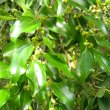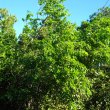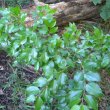Ziziphus mucronata
| Botanical Name | Ziziphus mucronata |
|||||||||||
| Family | Rhamnaceae - The buckthorn and jubjube familly. |
|||||||||||
| Pronunciation | ZIZZ-ih-fuss muh-kron-AH-tuh |
|||||||||||
| Common Name(s) |
English: Buffalo Thorn; Wait-a-bit
Afrikaans: Blinkblaar-wag-'n-bietjie; Haakdoring
IsiXhosa: umPhafa
IsiZulu: umPhafa
Sesotho: Mokhalo
Sesotho sa Leboa: mokgalô
Setswana: mokgalo
Xitsonga: mphasamhala
Tshivenda: mutshetshete
IsiNdebele: Umpafa
siSwati: umLahlabantu
|
|||||||||||
| Plant Group |
|
|||||||||||
| Plant Size |
|
|||||||||||
| Position |
|
|||||||||||
| General Information |
|
|||||||||||
| Specific Information | Ziziphus mucronata is said to be one of the most adaptable trees, growing in all types of soil and having the ability to withstand intense heat, cold, frost and drought. The thorns are paired along the stems, one facing forward and the other facing backward. |
|||||||||||
| Ad Break | ||||||||||||
| Flowers | ||||||||||||
| Description | dense clusters: inconspicuous |
|||||||||||
| Season |
|
|||||||||||
| Colour |
|
|||||||||||
| Growth Rate |
|
|||||||||||
| Plant Uses |
|
|||||||||||
| Distribution and Habitat | absent from the Western Cape but throughout the summer rainfall areas of sub-Saharan Africa, extending from South Africa to Ethiopia and Arabia, in woodlands, scrubland, on rocky koppies, open grasslands, beside streams, in valley bottoms and along forest margins |
|||||||||||
| Planting Suggestions | The buffalo thorn will grow in almost any soil type and can withstand heat and cold equally well. Mulch well and water regularly until established. Continue watering and feeding if you wish to speed up the growth process. The old method of digging a deep hole and filling it with soil and compost has resulted in many trees failing to thrive, dying, rotting at the base or worse still, falling over in later years due to poor root development. Refer to the following sites for the best method of planting trees: International Society of Arboriculture: New Tree Planting Tree People: Plant the right way For those of you who have a clay problem try: |
|||||||||||
| Lorraine's Garden Notes | There are a few of these trees in my wild garden, but they grow extremely slowly and only one has done reasonably well. This is most likely due to the high lime content of my soil and the frequent droughts we experience in our part of the Eastern Cape. I have seen these trees grow handsomely in other areas. |
|||||||||||
| Medicinal Uses | A well respected medicinal tree to which many beliefs and superstitions are attached. Roots, leaves and bark in various guises are used for painkillers, dysentery, respiratory ailments and to treat boils, swollen glands, wounds and sores. The berries are edible and were used by settlers in making porridge and as a coffee substitute. The buffalo thorn is used in connection with burial rites and in other parts of Africa a branch is dragged round the village to protect it from evil spirits. |
|||||||||||
| Ad Break | ||||||||||||










Comments
Marico uses for Ziziphus mucronata
Good for respiratory ailments- barks is cut in lengths (always down and not across as this damages the tree and this is boiled for a hour. Lovely earthy smell and taste and will relieve chest pain rapidly. Best use for it is definitely to eat about 5 leaves to stop stomach cramps and for rapid relieve of a runny stomach. We ALL use this in Groot Marico and it works very well!
Practical use of Ziziphus mucronata
Hi Jacques
Thanks for your comment. This information will definitely save on doctor's bills!
Regards
Lorraine
Medicinal Properties
Has any work been done to isolate the actives in zizipus mucronata leaves and roots
Medicinal properties
Hi Munakadafa
There have been a number of scientific studies carried out in this area.
Google:
'isolate actives Ziziphus mucronata' and
'isolate actives in Zizipus mucronata'
There are many sites listed that refer to this topic.
Kind regards
Lorraine
ZIZIPHUS MUCRONATA
Good Day,
I am designing landscaping for my property and contemplating of specifying this species as a hedge, along the perimeter of the boundary fence, what is the root behaviour/system, can it be planted in close proximity to the buildings?
Regards
Mzi Gcanga
Root system of Ziziphus mucronata
Hi Mzi
The Buffalo thorn has a non-invasive root system and can be planted quite close to permanent structures.
Kind regards
Lorraine
ZIZIPHUS MUCRONATA
Hi Lorraine,
Can this tree be planted as a hedge?
Regards,
MZI GCANGA
Buffalo thorn as a hedge
Hi Mzi
It depends on how tall you want the hedge to grow. If you live in an area where there is plenty of water, the tree may grow up to 8 meters tall. Even as a small tree of 4 meters, this may be a bit too high for a hedge.
Kind regards
Lorraine
Mokhalo
This tree is believed to protect homes from lightning.
ziziphus mucronata
why to horses eat the bark. only observed it this year. really dry here and they have eaten all the bark off as high as they can reach. regards
Horses eating bark of Buffalo thorn
Hi Cherry
I have no idea. Perhaps they are hungry or the bark is juicy.
Perhaps someone who knows more about horses will be able to tell us more.
Kind regards
Lorraine
Discuss this plant
Share knowledge, ask a question or give an experience.